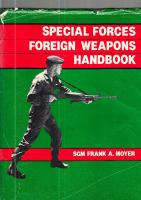U.S. Special Forces Recon Manual
US Special Forces Recon Manual - 1982.
156 120 54MB
English Pages 70 Year 1982
Recommend Papers
File loading please wait...
Citation preview
U.S. Special Forces
Recon Manual
COPYBIGHT
Lancer Militaria Sims, Ark.71969
USA 1982
t
PREFACE
The purpose of this manual is to provide a compendi-r:m of unclassified technlques and procedures used by reconnaisance patrols. It is no sub-
shftute for unit SOPs. Nor do any of the techniques in this nanual represent the lagt _yord. The success of any recon operation depends on the ability of the unit to develop its own procedures and to adapt and explolt those which pro-ye successful. Ultimately, of course, success depends on the motivation and training of the reeon team. This manual w111 provlde an introduction to the required training and a basis for continuanee of tralnlng. While no technique represents the final answer, those described here have been proven successful in several years of combat. To the beginner, thls book wi-l-l serve as a suunary of the techniques he must naster; to the "o1d-ti.mer", it will be a refresher and review. There is on1-y one type of recon man that has stopped learning recon - the dead type. This book is directed only towards RT enpl-oynent. Therefore, always keep ln mind that taetics and techniques are directed towards one goal; the collection of intelligence. The patrolling tactics, lnsertion techniques, cornmunicati.ons, etc. are only means to accomplish that end. (Publisherrs note: This manual- was developed for instruction purposes at the United States Army Institute for Military Assistance during the early 1970s. It contai.ns information very hard to find elsewhere, much of it in the form of "l-essons learnedtt from experiences ln Southeast Asia. I,Ie felt that the informati.on presented here deserved to be readily avail-able to the nilitary professional and we hope you will flnd lt useful in all of your military endeavors.)
\ ?1 l.
II. III.
OF TABIE _.-_-_____
CONTENTS
-otganlzation and Composition of RTsi:-'-' RT EqriiPrle-nt. . . rr'..'r-a.-:
Premissiou-r-qePJitG;Techniques" Alr -tnflftratioiTi*iiltr"tton IV'' ?atrolling Techniques'' v. Tracking and Use of n**o S.ns"s'in Obtaining vr. VII. Intel-11gence.. VIII. FAC/FAG Procedures. .. . Employnent of ArtillerY' rx. x.
Foreigo
[,IeaPons
8 """ " . - - -:: . .::: ::: .:::l; Combat Intallige'ce ""47 " " '53 ......77 92 96
CHAPTER
I
ORGANIZATION AND COMPOSITION OF RTS
1.1 GEMRAL. There are essentially two basic recon teams--the 12-man team and the six-man team. Often the team will be augmented or diminished for specific missions. It is desirable that the RT leader be given a voice in determining the size and composition of the team during the planning phase of a mission. L.2 and
TI{E SIX-MAN TEAM. The six-man Eeam is usually composed team mernbers. It is made up as follows:
four indigenous a.
10 Team Leader (US).
b.
11 Assistant Team Leaderfradio operator (US).
c. 01 Indigenous
of two Americans
Team Leader.
d. 02 Interpreter.:k
1.3
e.
03 M79 man.*-
f.
04 Scout.*
THE 12-MAN
a.
TEAI'I. A typicaL l2-man team may be organized as follows:
10 Team Leader (US;.
b. lL Assistan! Team Leader c.
12 Radio Operator (US).
d. 01 Indigenous
Team Leader.
e. 02 Interpreter.* t.
03 M79 man.*
g.
04 M79
man.?k
h. 05 Scout.* i.
06 Scout.
tc
j . 07 Scout.
r

![US Army Special Forces Medical Handbook [Reprinted]
0806510455, 9780806510453](https://ebin.pub/img/200x200/us-army-special-forces-medical-handbook-reprinted-0806510455-9780806510453.jpg)
![Special Forces Guerrilla Warfare Manual [Reissue ed.]
0873649214, 9780873649216](https://ebin.pub/img/200x200/special-forces-guerrilla-warfare-manual-reissuenbsped-0873649214-9780873649216.jpg)


![US Army Special Forces Medical Handbook [1 ed.]
0739405748, 0873644549, 9780739405741, 9780873644549](https://ebin.pub/img/200x200/us-army-special-forces-medical-handbook-1nbsped-0739405748-0873644549-9780739405741-9780873644549.jpg)



![Special Forces: Soldiers (1980-1989) [Director's Cut ed.]](https://ebin.pub/img/200x200/special-forces-soldiers-1980-1989-directors-cutnbsped.jpg)
